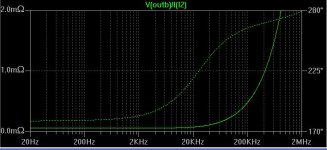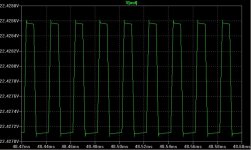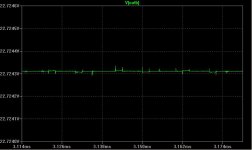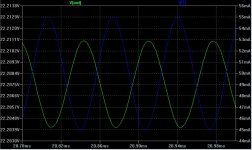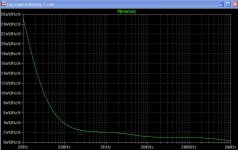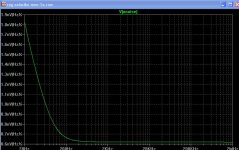There are several models of the IRFP9240 (the mosfet recommended in the salas regulator) that generated these plots. What I showed previously was with a model found on the web. Using the ltspice provided model changes things a little bit, for the better. I guess the moral of the story is that we can't trust a simulator much?
Attachments
It looks like the Teddy Reg has better flat bandwidth but at a higher output impedance.
What is better flat impedance bandwidth at higher output impedance or lower bandwidth at lower impedance?
What is better flat impedance bandwidth at higher output impedance or lower bandwidth at lower impedance?
I would say the teddy reg performs better, having a flat frequency response is better than ultimate low impedance, low noise is of prime importance. Try both and listen which one sounds best.
I would expect any current sourced discrete shunt to sound different to a full series circuit like a pre regulated gyrator. Its down to actual comparisons I guess. I agree you have to listen to both, in order to decide.
and perhaps it also is dependent upon each application . . .
who can say one regulator sounds best in all applications.
I can't because I did not try it yet - but I will do so very soon 🙂
. . . and of course it may be we not all agree about what is best - hehe
I tend to think that if two or more applications or elements share one reg then low o/p impedance is important to avoid a confused sound.
if one reg serves only one application then perhaps it may be more to down to individual preference
who can say one regulator sounds best in all applications.
I can't because I did not try it yet - but I will do so very soon 🙂
. . . and of course it may be we not all agree about what is best - hehe
I tend to think that if two or more applications or elements share one reg then low o/p impedance is important to avoid a confused sound.
if one reg serves only one application then perhaps it may be more to down to individual preference
homemodder said:I would say the teddy reg performs better, having a flat frequency response is better than ultimate low impedance, low noise is of prime importance. Try both and listen which one sounds best.
So, consistently bad is better than 3/4 good and 1/4 bad? 🙂
I agree that as far as sound is concerned everyone should make their own opinion.
However, you also have to look at the scale of these plots. The plot for the superteddyreg is like looking from distance at a range of hills. If you get closer you'll see a lot of irregularities where you first saw nicely rolling hills. The plot for the salas regulator is very zoomed in.
Also, for a moment, think about what output impedance means in terms of behaviour of the regulator. Large output impedance means that the regulator is faced with a change in load current and it cannot make the necessary adjustments to keep the output voltage steady. Lower impedance means smaller change in the output voltage for the same load current change. If the input voltage to your preamp/amp varies quite as the load current varies (can you say bass?) does it matter how flat the output impedance is, as long as is high? Will the sound be affected?
The second issue here is, flat where? Flat to 40kHz is good enough? Flat to 100kHz? Flat to 2Mhz?
I think you make some very valid points ikoflexer.
However with my limited building experience I might build both and see if I can discern any audible differences.
My main application is for preamps eg B1, BOZ.
Hey Ikoflexer, could you please do a simulation of the Bride of Zen power supply I would like to know how it compares.
However with my limited building experience I might build both and see if I can discern any audible differences.
My main application is for preamps eg B1, BOZ.
Hey Ikoflexer, could you please do a simulation of the Bride of Zen power supply I would like to know how it compares.
Salas,
I`d like to confess that I find your regulators technically irreproachable, having a clean simplicity, in sharp contrast to the extremely muddy design of this thread. I`m only wondering about the position of C3/R6.
I`d like to confess that I find your regulators technically irreproachable, having a clean simplicity, in sharp contrast to the extremely muddy design of this thread. I`m only wondering about the position of C3/R6.
There is nothing wrong with this thread's design. Its a communal process with lots to learn about reg thinking and ways of getting around issues. An open shunt school.
As for questions and experiences about my simplistic Mosfet shunt, Ikoflexer opened a thread, and we better discuss there. If we discuss more here it is hijacking I am afraid.
As for questions and experiences about my simplistic Mosfet shunt, Ikoflexer opened a thread, and we better discuss there. If we discuss more here it is hijacking I am afraid.
Guys, I'll never suggest that you don't build something for yourself and let no one tell you that. It's the only way to really dig a circuit.
Just so you understand my stance here, I'll explain myself a bit. I try to keep my interest in technicalities a bit separate from my interest in good sound. At obvious times they converge, but many times I want them separate.
So, back to technicalities. This is how the superteddyreg voltage output will vary with a square wave load that goes up and down every 10uS from 50mA to 55mA.
Just so you understand my stance here, I'll explain myself a bit. I try to keep my interest in technicalities a bit separate from my interest in good sound. At obvious times they converge, but many times I want them separate.
So, back to technicalities. This is how the superteddyreg voltage output will vary with a square wave load that goes up and down every 10uS from 50mA to 55mA.
Attachments
Hi,
post551 looks like 1.6mVpp of spikes & ripple on the output.
I cannot imagine that sounding great.
What would it look like with a sinewave @ high frequency?
post552 looks like it's PSRR is 38dB better.
post551 looks like 1.6mVpp of spikes & ripple on the output.
I cannot imagine that sounding great.
What would it look like with a sinewave @ high frequency?
post552 looks like it's PSRR is 38dB better.
Worse output inpedance is not going to make much of a difference soundwise, what is important with the teddyreg is that it should be used only with load thats draw constant current such as preamps etc that are in class A. In small preamp cicuits biased in class a there is no changes in load current, however low noise is of prime concern. How does the the circuits measure up ??
Thanks ikoflexer.
The sims are really informative. I will be waiting for BOZ power supply. It is a very simple circuit so it shouldn't take long.
The sims are really informative. I will be waiting for BOZ power supply. It is a very simple circuit so it shouldn't take long.
I can't help being amused by those who can look at a circuit or simulation, neither of which have any good relation to reality anyway, and then decide which sounds best.
Unless you have such an incompetently designed amp that anything on the supply immediately shows up in the sound....😉
Jan Didden
Unless you have such an incompetently designed amp that anything on the supply immediately shows up in the sound....😉
Jan Didden
... or simulation, neither of which have any good relation to reality anyway
Reality sucks. I am still testing my new prototype, but found already that the main current source is happily oscillating somewhere below 2 MHz. I omitted the miller capacitor that Nelson Pass has in his current source (ZEN V2, figure 1, C3) and which is otherwise the same version I am testing, because in simulation I did not see any effect of this cap or any oscillations either. Putting it back in cured the oscillations.
Off course, I could have wondered why he put it in there in the first place.
- Status
- Not open for further replies.
- Home
- Amplifiers
- Solid State
- Bipolar discrete shunt regulators
